By Rob Sterry, Principal Consultant, Foolproof
This article highlights some great examples of personalisation. All of them provide a personalised in-app digital experience opposed to personalised marketing. We think this form of personalisation drives better value and is less intrusive.
Spotify — algorithms driving engagement
Spotify intelligently use information based on your listening behaviours and patterns to make suggestions about new music. The new music which is offered in playlists have particular names and explanations. This helps users to understand why this has been displayed to them.
These lists are also easy to navigate into and out. This means as a user you don’t lose sight of the journey you were on previously (your own playlists and preferences), whilst allowing room for exploration and serendipitous experience.
It’s well known that they have an AI engine which helps with recommending music to users.
“[Spotify’s] home screen is governed by an A.I. system called BaRT (“Bandits for Recommendations as Treatments”). The system’s task is to organise each home screen in a personalised way for each user.”
It does this by using information about you with the information other users like you have provided to make personalised recommendations about future listening.
What’s more, the
algorithm analyses the music which people listen to understand the elements of
the composition that people like and the similarities and differences inherent
within them.
The algorithm also makes improved recommendations over time based on the
information it gathers about the listening behaviour users show on the
playlists it has recommended.
Duolingo — tailored learning
Duolingo is an app with great onboarding it also uses AI to deliver personalised language learning. When trying a new language on the platform you go through a proficiency assessment.
As you go through this process each question you answer is determined by the answer you’ve given previously as part of the process. This builds your own language profile which tailors questions to you.
Here personalisation is powered by deep learning, an AI which mimics neural pathways. The AI makes intelligent predictions based on a users’ previous response history using natural language processing – your response to any given question is fed back in.
This personalises future learning experiences — whether you recognised or failed to recognise a word may increase or decrease the amount of times it comes up again, and the context in which it does.
Nike Run Club — personalisation for re-onboarding
Sports applications are big on the personalisation front — they collect a lot of data and use it well. We’ve chosen one example – Nike Run Club. It has tailored messaging, remembers previous routes taken, replays activity and makes coaching suggestions for improvement.
If you don’t keep to your training plan — i.e. failing to run – it offers you different content the next time you open the app. Rather than treating someone as a dead user, or using marketing messages to guilt them into using the app it uses content which encourages users to return.
It follows this with messaging about reasons for not running with options like, “stress”, “injury”, “time poor” and “it wasn’t for me”. By choosing any given option the content adapts.
It uses names in the messaging and augment the experience you’d typically have. This is powered by content with a little bit of humanity based on information provided by the user.
Headspace — personalised content for you
Headspace is an application which helps alleviate stress with sounds and visuals. It orders the content a user has listened to first by positioning it highly on their playlist. Important given the context of use, users visiting the application may need quick access support or comfort.
Headspace also makes smart recommendations off of previous listening behaviours. It highlights content people otherwise wouldn’t have looked for or known about based on what they’ve listened to before.
Clue — personalisation improved health autonomy
Clue allows women to track their menstrual cycles. You can tag different aspects of your cycle to see patterns relating to your hormones and to predict when you are most fertile. With this data it surfaces content based on what you’ve tagged as relevant to you.
It’s up to you what you track, and your decisions allow you to further personalise your experience. If you’re not interested in something you won’t see it.
The premium version responds further to user needs by making smarter recommendations. This creates a more complete picture of month to month cycles and the nuances of each. The more data you record, the more personalised and intelligent response the platform gives.
This alleviates the strain on healthcare professionals and provides a great user experience which gives people autonomy and confidence over this aspect of their health.
Wrapping up
A lot of these examples are standalone apps or product/service success stories — not parts of a bigger experience. Personalisation works best if it’s scoped in at the start before any design or development takes place. This is because implementing personalisation well can be tricky.
At Foolproof we advocate for personalisation to be part of your experience strategy from the start.
If that’s not possible don’t be put off starting just be mindful of what you need to consider.









